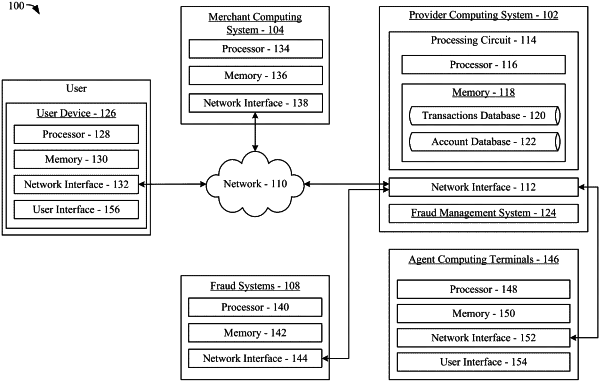| CPC G06Q 30/0185 (2013.01) [G06N 20/00 (2019.01)] | 8 Claims |

|
1. A provider computing system comprising:
a network interface structured to facilitate data communication via a network;
a database structured to store information associated with accounts held by an institution associated with the provider computing system; and
a processing circuit comprising a processor and a memory, the processing circuit structured to:
train a machine learning model utilizing training data, wherein the training data comprises test data and validation data associated with previous fraud cases and historical transaction data, the machine learning model configured to output a set of rules;
receive sets of fraud cases, each fraud case having transaction data and an initial priority score;
generate a plurality of queues associated with the initial priority score;
determine an updated priority score for each fraud case based on the transaction data and case prioritization data, the case prioritization data comprising the set of rules developed using the machine learning model, wherein the set of rules are based on the transaction data including for each fraud case a type of authentication used in a corresponding transaction and a travel characteristic of an account holder associated with the corresponding transaction;
update the plurality of queues based on at least one of the updated priority score, a first group, or a second group;
assemble the first group of the fraud cases in a single database based on the updated priority score;
perform an action on the second group of the fraud cases based on the updated priority scores, wherein the action comprises at least one of automatically closing a fraud case or transmitting an alert to a user device of an account holder associated with the fraud case, wherein automatically closing the fraud case comprises removing the automatically closed fraud case from the memory, such that a processing time for the action is reduced;
assign at least one of the first group of the fraud cases to a fraud agent computing terminal associated with a fraud agent responsive to determining that a first priority score of the at least one of the first group of the fraud cases is at or above a predetermined threshold, wherein assigning the at least one of the first group of the fraud cases to the fraud agent computing terminal comprises moving the at least one of the first group of the fraud cases to a cache;
receive an input from the fraud agent computing terminal regarding a disposition of an assigned fraud case;
update the machine learning model based on the input, the transaction data, and the initial priority score for each fraud case of the second group of the fraud cases that have been automatically closed; and
restructure the case prioritization data based on the updated machine learning model comprising retraining the machine learning model using an updated training data having the disposition of the assigned fraud case.
|